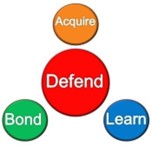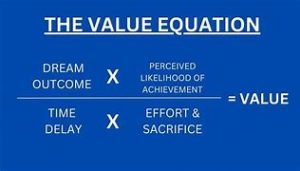All emotionally impactful Writing starts with story.
“Some travelers come to a village, carrying nothing more than an empty cooking pot.
Upon their arrival, the villagers are unwilling to share any of their food stores with the hungry travelers.
Then the travelers go to a stream and fill the pot with water, drop a large stone in it, and place it over a fire.
One of the villagers becomes curious and asks what they are doing.
The travelers answer that they are making “stone soup”, which tastes wonderful and which they would be delighted to share with the villager, although it still needs a little bit of garnish, which they are missing, to improve the flavour.
The villager, who anticipates enjoying a share of the soup, does not mind parting with a few carrots, so these are added to the soup.
Another villager walks by, inquiring about the pot, and the travelers again mention their stone soup which has not yet reached its full potential.
The villager hands them a little bit of seasoning.
More and more villagers walk by each adding another ingredient.
Finally, the stone (being inedible) is removed from the pot, and a delicious and nourishing pot of soup is enjoyed by travelers and villagers alike.
Although the travelers have thus tricked the villagers into sharing their food with them, they have successfully transformed it into a tasty meal which they share with the donors.”
When writing for emotional impact.
When I first heard this story, I felt it reminded me of the way good copy is written.
Or should I say, “assembled?”
You start out with a stone (your writing talent), you put your talent into a pot (your project), and you place it over a fire (meaning you start getting enthusiastic about the outcome.)
But now you must add ingredients. So, you do your research. You find out how your prospect thinks.
Then you assemble your sales copy with these ingredients… Their Problem:
You must clearly understand my situation and what caused it.
Their Emotions:
You must know what I’m feeling right now. Their Pain:
The symptoms that are causing me unbearable pain every day of my life in many ways.
Your Solution:
You must have found the answer that fits my problem precisely. Explain it Clearly:
You must be able to tell me in a way I clearly understand why you are best. Make it Compelling:
You have to convince me beyond any shadow of doubt why I should act. Urge Them to Act:
I must want to get your solution more than you want to sell it to me.
Then you spice it up with… Your back story.
Then you add a sprinkling of proof, or ‘the science behind.’
You need a handful of exciting, enticing benefits.
Of course, all of these improve the “flavour” of your sales copy, but you still
need that special sauce, the seasoning and even the spice.
They come in the form of…
- Testimonials.
- Solid guarantees.
- Painting a vivid picture of what their future will look like.
- And overcome any last-minute objections.
Now you have a “tasty meal” you can share with the world.
The structure of sales copy. Aka writing for emotional impact.
Today, more than ever, people are either bored or skeptical. You need to entertain people with your copy.
And because fiction outsells non-fiction by 500 to 1, its time we copywriters studied fiction and use some of its best ideas.
Recently I watched “Bird Box,” a movie starring Sandra
Bullock. It’s a thriller, and every scene keeps you glued to the screen. The movie starts out with a great pattern interrupt.
She’s down on one knee looking up at two young children and telling them they are about to embark on a treacherous journey, and they must always wear their blindfold otherwise they will die.
Then you see them get in a boat blindfolded and heading down a wide river.
Next, you are placed in the middle of a scene from five years earlier where the dialogue between our hero (Sandra Bullock) and her sister.
The dialogue has only one purpose.
To reveal her backstory while at the same time getting you to like and care about what happens to the hero.
Think of it this way, you pleasantly surprise your prospect into becoming compliant just long enough to allow you to establish a BOND with them.
If you are ethical and have their best interests at heart.


Above is my “Persuasion Equation.” You start by getting past their defenses, aka the pattern interrupt. Then you bond with your reader. Next you tell them about what you have for them so the “learn” about you and what you do.
Then and only then are they receptive to “acquiring” your product or service,
You must begin by distracting them from the thoughts they are having.
In other words you grab their attention with your unusual choice of words.
When you create a great back story, you shortcut the “getting to know like and trust” you part of any new relationship.
That is where you build a bridge between DEFEND and BOND. The four circles here represent the four core drives all of us have.
The main problem you face when writing sales copy is to get past their defenses so you can begin to BOND with them. The pattern interrupt is the best way I know of to do just that.
You create a bridge that immediately allows you to cross from DEFEND to BOND.
interests at heart, they won’t object.
How to instantly bond with your reader.
Use story, metaphor, simile or any one of several rhetoric devises. These special ‘play on words’ are what people enjoy reading or listening to. One of my favourites is, “He’s got more money than God’s ex-wife.”
From now on you’re going to create a folder with separate file labelled:
- Story.
- Metaphor.
- Simile
- Rhetoric.
Then have a notepad handy so whenever you read or hear any of these you jot them down.
There are several sources to get these from.
- Your friends and family.
- Books you read or listen to.
- TV shows, especially series fiction.
This helps keep your writing fresh and as entertaining as fiction.
Plus, you’ll have fun putting them into your copy. Remember you’re writing for emotional impact
I’ve studied over forty of the best writers who have ever lived, and they ALL use these “wordsmithing” tricks of the trade to make their sales copy sizzle.
(By the way, “sales copy sizzle” is a rhetorical device known as alliteration.)
Collect stories.
Like this one…
Many years ago, there was a robber, rapist and murderer who dies and ends up going to some afterlife place.
He gets to the afterlife and he’s not sure if he is in heaven or hell. He walks in
and there’s an angel there to greet him.
“While you’re here you can have anything you want. Just snap your fingers and it will appear.
You can have a fancy car, beautiful women, nice clothes, a yacht, anything at all.
But we only have one rule here, you’re not allowed to work.”
So, the man says, “Okay, fine with me, not a problem.”
And for the next few months he asks for everything he wants. Women, clothes, cars, whatever it is.
And this has gone on for several years.
Then he went back to the angel and said, “Hey, I’m bored, can I do something to repay you? Maybe sweep up a little bit, do the dishes, or something?”
“Ah, no sir, that’s not in the rules, you’re not allowed to do anything.”
The man says okay and gets on with his life asking for more things to enjoy.
And after a couple of years, he gets to the point where he just cannot take it anymore.
Once again, he goes back to the angel and says, “I can’t stand this anymore, I need to get out of here, please let me go. And just send me to the other place.”
The angel just looks at him and says, “Hey, guess what? This is the other place.”
The major distinction between heaven and hell is you can’t work for something.
you want.
That’s a great example of writing for emotional impact.
Now at this point you’ll want to connect this story to what you want your
reader to accept as true.
These types of stories are in fact, pattern interrupts. They hijack your readers consciousness and take them away from any thoughts of defending themselves and at the same time build a bridge between you and them.

Bet you weren’t expecting to see that. It is a great example of a pattern interrupt.
Where was I?
Just about everything fascinating story told well, creates a strong bond between the storyteller and the listener.
I’m sure you’ll know this to be true if as a child your parents told you stories at
bedtime.
Stories shut down your “inner critic” or your “critical factor,” and bypass any conscious effort to defend yourself.
This is usually happening below your awareness and as Kenrick Cleveland once told me, “There is no defense against this in real time.”
A pig farmer is working in his yard when one day a man appears and askes,
“What do you give your pigs to eat?”
“Trash and leftovers from the farm mostly,” replies the farmer.
“Well, this is a disgrace, I’m from the Animal Welfare Society and I hereby fine you a thousand dollars. It’s outrageous giving your animals trash.”
A couple of months later two different men come to the farm and ask the farmer the same question.
The farmer hesitates and then replies, “Well generally speaking, it’s high protein, low cholesterol. A typical lunch would start with lobster and smoked salmon, flowed by fillet steak, and lightly tossed green salad, and a low-fat raspberry yoghurt cake as desert.”
The two men became very angry. “How dare you. This is criminal. People are starving all over the world and you are feeding such food to pigs. We represent a charity called Global Food Redistribution and we’re fining you ten thousand dollars.”
A month or two later a woman shows up at the farm with a clipboard and asked the farmer, “What do you feed your pigs?”
The farmer gives he a long look and replies, “I give them a dollar each and they buy what they want.”

Two things…
How did you do? Were you able to stop and think about what you were reading and detach yourself emotionally?
Didn’t think so. Neither could I when I first read this, and I went on a hunt for you to find you another good story.
Second thing is this.
How could you use that story in your copy to make a point? And what point would you make?
Would it be that you don’t want to listen to conflicting advice when you’re
quite capable of making your own mind up?
Or would it be that it’s only through experiencing life first-hand can you gain wisdom?
There are, of course, many possible interpretations you can use depending on what it is you want the reader to believe without question.
Creativity on tap.
One school of thought is you “swipe” ideas from other successful promotions.
The other is you use originality and creativity together with insight.
The Netflix series “The Queens Gambit” answers this within the realms of chess.
Some world champions used their memory to recall hundreds of games, if not thousands, so they know what to play in any given situation.
Others like Bobby Fisher and Judit Polgar are more intuitive.
In case you don’t have seven hours to invest in watching, I’ll give you my
(biased) answer.
Go with creativity if you want to make money in the long run.
There are several ways to become more creative. In my early years of copywriting, I used “The Creative Whack Pack.”
Meditation is not what you think.
Another creativity “tool” I use is meditation.
Find music with isochronic tones and whenever you feel you need some inspiration, find a quiet place, and shut off all distractions for 20 – 30 minutes.
While you’re meditating, actively seek the answers you’re looking for.
Wait at least six minutes into your meditation to do this.
Some days I will spend up to two hours meditating, most time I find what I’m
looking for.
If you don’t like the idea of meditating, fine, then go for long walks. Don’t
take any electronic gismos with you. Just pen and paper.
Ideally, you want to spend two or three hours each day thinking about what you will write.
If you’re a mornings person…
(By the way, I hate morning people, and mornings and people… J )
Then do you’re thinking later in the day and allow your sleeping brain to
conjure up answers.
If you’re an evening person, then spend your mornings thinking about what to
write.
Know this: Your best time to be creative is the EXACT opposite of being a morning or evening person.
Brain Training…
This I cannot recommend highly enough.
The concept is “Train hard – fight easy.” Train your brain every day and your writing will become easier and easier.
I’ve been doing brain training for well over fifteen years. And I know this to be one of the best kept secrets of ALL great copywriters.
Get the app Elevate and begin to improve the way your mind operates.
It has exercises for reading, writing, mathematics, listening and speaking.
Every one of these five skills you’ll need to become a skilled direct-response copywriter.
Notice how much time we’re focusing on anything other than copywriting? That’s because it’s what you do while you’re preparing to write is what makes all the difference to your writing.

Here is another example of writing for emotional impact…
Emperor Hirohito of Japan was making a state visit to Thailand.
Everyday his itinerary was painstakingly planned to the last minute.
It was a punishing and precise schedule.
One particular Friday the emperor and his entourage were booked to visit a small Buddhist temple for exactly ten and a half minutes to talk informally to some of the monks.
The emperor and his party entered the temple precisely on time, but the monks were nowhere to be seen.
The aide responsible for the emperor’s schedule was mortified. In panic, he first looked to find the monks, then made lame excuses for their absence.
But the emperor was not perturbed. He stood silently in the center of the room totally at peace with himself.
Precisely ten and a half minutes after they entered, the emperor signaled it was time to move on. On his way out of the temple, Hirohito turned towards is aide and said, “Thank you, I enjoyed our appointment very much. Please schedule me another one tomorrow.”
Make good use of your “spare” time. Meditate more. Reconnect with the inner and outer worlds. Practice the art of slowing down time.
Your Back Story.
In the “Persuasion Equation” model you were introduced to the concept of getting past people’s natural defenses by creating a bridge between DEFEND and BOND.
Your next step is to create a BOND of trust, liking and a feeling that they already know you.
You’ll do that with your back story.
Stories Speed Up Rapport:
A story can drastically speed up the process of learning who you are, and thus trusting you.
Instead of having to discover who you are over a long period of time, a story can stimulate them to see that quickly.
Stories mesmerize people. They fit into the indirect, permissive model of persuasion not the old-fashioned direct authoritarian model.
New York Times and CBS News Poll
. 63% believe that in dealing with most people, you can’t be too careful.
. 37% believe that most people would try to take advantage of you if they had the chance.
. It also showed that the people taking the poll believe that of the people they know,
. 85% would try to be fair. That is, of the people they know.
Use a story to let people know who you are and your trust worthiness almost triples.
Creating Your Story
(or how you became a Hero)
.Joseph Campbell detailed the Hero’s Journey in his work with Myths. This journey is found in most films and in stories that move us.
. The purpose of using this process is to create a compelling story.
. Stories have at their core some key aspects:
. They reduce resistance.
. They move those hearing it past critical thinking filters during the story.
. They lead people to their own conclusion. but it is a conclusion the story helped to shape.
What you can learn from reading or watching fiction.
Every great work of fiction has a main character (or heroine) that is the focal point of the story. There is also the villain. The stronger the villain the better our hero must be and the better the story.
Both the heroine and the villain have likable character traits.
However, the hero has a lot more and they are structured in such a way that we the reader or viewer can’t help ourselves liking and caring about him or her.
The opposite is true of the villain, we can’t help ourselves not liking him or her.
And so, we have conflict, without which there will be no story worth following.
You must decide who your villain (aka common enemy) is going to be.
It could be your ex-partner in business or in life. It could be the government. Pharmaceutical companies, your bank, your own self-sabotaging behaviour, etc.
What it must be is the same common enemy your reader shares with you otherwise your story won’t work.
Spend some time reflecting on your history and see if you can find a villain both you and your reader have in common.
Next, we’ll look at the types of traits that will make people want to get to
know, like and trust you.
Note: You’re doing all of this to do away with the need to sell yourself or your
product or service.
The time you spend thinking about this will pay you back immensely.
Character traits.
There are three types of “heroes,” and their corresponding emotions. There’s the hero, the average Joe, and the underdog.
PART ONE.
PLEASE CHOOSE ONLY ONE OF THESE THREE.
The hero is superior to the reader and produces admiration. Although they are
not perfect, they’re confident about their skills and act without hesitation.
They have no ambivalence, no self-doubts. We don’t identify with them; we
fantasize about being them.
They give us a taste of who we could really be.
The Average Joe is equal to the reader. This results in sympathy because we recognise ourselves in them, and thus identify with them, their desires, and their needs.
These characters struggle to rise above their doubts, limitations, and obstacles.
The Underdog. This character is inferior to the reader. They are the unlikely hero.
The odds are against them. There outmatched by antagonistic forces and
overwhelmed by them. So, we’re inclined to protect, help, or console them as the
story progresses.
The Underdog is an appealing protagonist because he makes us feel free emotions – compassion for their lack of self-esteem or resources to be successful, including a physical, emotional, social, or mental handicaps; admiration for their determination to try and overcome their obstacles and take control of their lives; and suspense for the implausibility that they’ll succeed, the odds being so stacked up against them – will this person pull it off?
And if so, how?
Traits.
Once you establish your character type, it’s time to give him or her traits. Obviously, you’ll want more than one trait because it’s impossible to feel for
somebody who is one-dimensional.
Real people have many layers – emotional, psychological, and intellectual. You’ll also want several attributes, preferably a mixture of positive, neutral, and negative traits.
A character that is all good or bad would not be credible or interesting.
Values.
You also must have an individual point of view, beliefs, attitudes, and values.
Flaws.
The idea is to make you likeable; it doesn’t mean that you have to be perfect. Human beings aren’t perfect. And people will bond with characters who have flaws.
Flaws, which can include negative traits, fears, lack of objectivity, resentments, psychological wounds, or other emotional troubles, add colour and dimension to characters by making them more human.
You want your reader to wonder how the character will triumph despite his flaws. These struggles produce some of the most compelling emotional moments in stories.
What do you want? (Desire, goals.)
Desire is the spine of your story, and any obstacle to that desire is conflict, which in turn produces emotion.
All stories are about people who want or need something. Without a goal, there’s
not much of a story.
(Please write out what it is you want. Is it your own business? Autonomy. To create a cause, etc.)
Why do you want it? (Need, motivation.)
All behaviour is motivated. Motivation is the mental force that makes us act, the why of every behaviour.
(To answer this question, write your answers below):
Why do I want this?
And why do I want that? And why do I want that? And why do I want that? And why do I want that?
What happens if you fail? (High stakes.)
What have you got to gain or lose? What happens if you fail? What happens if you succeed?
(Write your answers here.)
How do you change as the story progresses? (Character arc.)
The last piece of the puzzle is the characters arc. And how he or she changes emotionally from beginning to end. The change can be physical, behavioral, mental, or emotional.
Because change is difficult and stressful, it adds conflict. It also gives the story a sense of significance and importance that was worth reading or watching.
Who did you become as you went through your journey to get what you want?
Part 2.
The hero is superior to the reader and produces admiration. Although they are not perfect, they’re confident about their skills and act without hesitation.
They have no ambivalence, no self-doubts. We don’t identify with them; we fantasize about being them.
They give us a taste of who we could really be.
The Average Joe is equal to the reader. This results in sympathy because we recognise ourselves in them, and thus identify with them, their desires, and their needs.
These characters struggle to rise above their doubts, limitations, and obstacles.
The Underdog. This character is inferior to the reader. They are the unlikely hero.
The odds are against them. There outmatched by antagonistic forces and overwhelmed by them. So, we’re inclined to protect, help, or console them as the story progresses.
The Underdog is an appealing protagonist because he makes us feel free emotions – compassion for their lack of self-esteem or resources to be successful, including a physical, emotional, social, or mental handicaps; admiration for their determination to try and overcome their obstacles and take control of their lives; and suspense for the implausibility that they’ll succeed, the odds being so stacked up against them – will this person pull it off?
And if so, how?
Traits.
Once you establish your character type, it’s time to give him or her traits. Obviously, you’ll want more than one trait because it’s impossible to feel for somebody who is one-dimensional.
Real people have many layers – emotional, psychological, and intellectual. You’ll also want several attributes, preferably a mixture of positive, neutral, and negative traits.
A character that is all good or bad would not be credible or interesting.
Values.
You also must have an individual point of view, beliefs, attitudes, and values.
Flaws.
The idea is to make you likeable; it doesn’t mean that you have to be perfect. Human beings aren’t perfect. And people will bond with characters who have flaws.
Flaws, which can include negative traits, fears, lack of objectivity, resentments, psychological wounds, or other emotional troubles, add colour and dimension to characters by making them more human.
You want your reader to wonder how the character will triumph despite his flaws. These struggles produce some of the most compelling emotional moments in stories.
What do you want? (Desire, goals.)
Desire is the spine of your story, and any obstacle to that desire is conflict, which in turn produces emotion.
All stories are about people who want or need something. Without a goal, there’s not much of a story.
(Please write out what it is you want. Is it your own business? Autonomy. To create a cause, etc.)
Why do you want it? (Need, motivation.)
All behaviour is motivated. Motivation is the mental force that makes us act, the why of every behaviour.
(To answer this question, write your answers below):
Why do I want this?
And why do I want that? And why do I want that? And why do I want that? And why do I want that?
What happens if you fail? (High stakes.)
What have you got to gain or lose? What happens if you fail? What happens if you succeed?
(Write your answers here.)
How do you change as the story progresses? (Character arc.)
The last piece of the puzzle is the characters arc. And how he or she changes emotionally from beginning to end. The change can be physical, behavioral, mental, or emotional.
Because change is difficult and stressful, it adds conflict. It also gives the story a sense of significance and importance that was worth reading or watching.
Who did you become as you went through your journey to get what you want?
Part 3.
HERO’S JOURNEY STORY QUESTIONS.
NOTE: Read through this first and then take a break. Come back and answer these questions a day or so later.
To walk you through the steps of this, all you need to do is answer the questions
below, and I’ll write your story in the correct sequence.
Here are the questions:
Backstory:
What is your backstory that gives us a vested interest in your journey? In other words, using one of the character traits above to show your reader why they should care about what happens to you.
Desire:
What did you want to do, create, or accomplish? (Use what you wrote earlier.)
External: What external struggle were you dealing with? Internal: What internal struggle were you dealing with?
The problem you first encountered.
What wall or problem did you hit within your current opportunity to start you on this new journey?
What insight, epiphany or “ah-hah” moment did you experience?
What was your breakthrough moment or the new opportunity you discovered?
Plan of action.
What plan did you hatch up, conceive, or create to achieve your desire?
Conflict with the common enemy.
What conflict did you experience along the way? How did this set you back? Did you feel like giving in or giving up?
Achievement:
What was the end result you achieved?
Transformation:
What transformation did you experience? In other words, what changed in the way you now think, act, and behave? What resources did you create that you’re now bringing back to other people, so they never have to suffer the way you suffered.
By completing this module, you have just put yourself way ahead of 98% of your competitors.
If you’ve done this as a part of the Influence Intelligence home study copywriting
course, well done.
If you’ve done this to help me craft your compelling story – thank you. I can now do my magic for you.
Trust your unconscious mind.
A horse with no identifying marks wandered into a farmyard. The farmers
youngest son said he’d take responsibility for returning the horse to its owner.
The boy mounted the horse, urged it towards the road, and let it choose its own direction.
The boy actively intervened when the horse stopped to graze or wandered off the lanes and into a field.
Otherwise, he just sat on the horse.
When the horse finally ambled into a farm several miles away, the farmer said, “How did you know to bring him here hey, how did you even know it was our horse?”
The boy said, “I didn’t know. The horse knew. All I did was keep him on the road.”
Below is a video I made for you to reinforce what you just learned. This reminds me of the saying, “If you show me what books a person reads I can tell you things about her. But if you tell me what she rereads I can tell you everything about her.
My way of thanking you for reading all the way to the end – and watching the video.
Put your best email address below so I can send you my favourite story templates to help you become an ace copywriter that attracts new clients to you.




